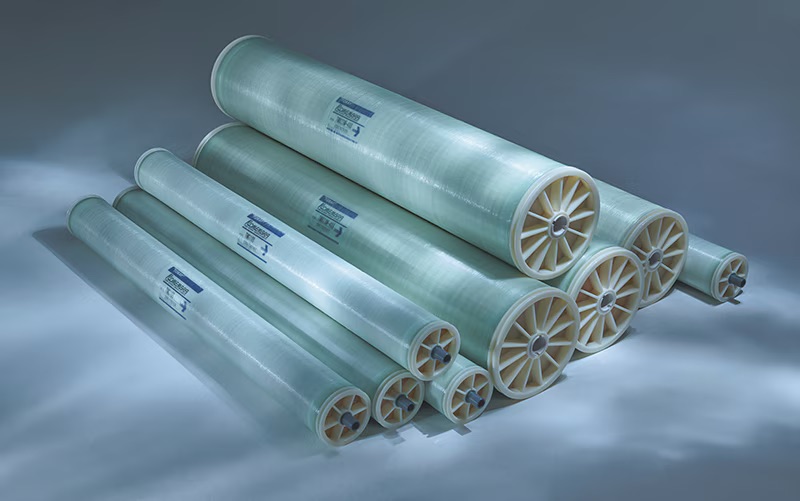Toray Releases Reverse Osmosis Membrane Elements that Double Impurity Removal to Produce Ultrapure Water from Recycled Wastewater
Toray Industries, Inc., announced that it began advance sales to domestic water treatment engineering companies within the course of this month of the TBW-XHR series of reverse osmosis (RO) membrane elements (see note 1) . These neutral molecular high-removal, low-pressure elements double urea removal efficiency when using recycled wastewater (note 2) in producing ultrapure water suitable for such fields as semiconductor manufacturing.
Increasingly severe global water shortages have prompted semiconductor manufacturers to consider using recycled wastewater and seawater as sources for ultrapure water for manufacturing semiconductors, augmenting efforts to increase wastewater reuse at foundries, which consume huge volumes of ultrapure water.
Production of ultrapure water from these water sources requires advanced technology capable of removing salts, silica, boron, urea, alcohols and other impurities. Urea poses a particular challenge, as it impacts both the safety of drinking water and in the quality of ultrapure water used in photolithography processes for semiconductor manufacturing. Highly efficient urea removal is crucial to meet stringent demands of this application.
The urea concentration in conventional recycled wastewater is about 30 micrograms per liter, or around three times higher than in tap water. The ultrapure water production process requires maximum urea removal. Urea is hard to remove, however, owing to its small molecular size and electrically neutral nature, much like boron in seawater. Improving removal rates for urea and boron while maintaining high water production rates has been a significant challenge in developing RO membranes.
By innovating the RO membrane manufacturing process, Toray developed a new membrane structure control technology that allows selective water permeation and enhances the removal of urea, boron, alcohol and other substances. These efforts culminated in the TBW-XHR series of RO membrane elements, whose urea removal efficiency is double that of conventional systems, achieving high water permeability at low pressure.
The company employed advanced analytical technology from Toray Research Centre, Inc., in developing this product. Internal evaluations found that urea removal efficiency is nearly 90%, contributing to a stable supply of high-quality ultrapure water needed by advanced semiconductor fabs. The technology reduces urea levels by half compared with conventional methods, supporting ultrapure water production from recycled wastewater.
This product addresses the demand for improved water quality in current ultrapure water production systems. It could play an important role in constructing new systems, such as those using recycled wastewater. Advance sales are made to domestic water treatment engineering companies handling ultrapure water production equipment for semiconductor and electronic component plants. Toray plans to expand applications overseas, including seawater and brackish water desalination and wastewater reclamation.
Toray will present the technology underlying this product at the annual conference of the International Desalination and Reuse Association, one of the world’s largest water treatment associations. This event will be in Abu Dhabi, United Arab Emirates, from December 8 to 12.
RO membrane elements are water treatment membrane products with diverse applications, including seawater desalination, industrial water production, wastewater reuse and drinking water production. In addition to RO elements, the company offers a wide range of water treatment membranes and technical services, including ultrafiltration membrane modules for turbidity removal and membrane bioreactors for wastewater treatment. Toray will continue developing and marketing advanced materials that contribute to sustainable social progress.
Glossary and supplementary information
1. Reverse osmosis membranes
When a semipermeable membrane separates concentrated and dilute aqueous solutions, water moves from the dilute solution to the concentrated one through osmotic pressure from different concentrations. Applying pressure greater than the osmotic pressure on the concentrated side forces water through the membrane to the dilute side. This process is called reverse osmosis. Reverse osmosis membranes target the removal of metal ions, such as sodium and calcium, such anions as chloride and sulfate, and pesticides and other small-molecule organic compounds.
2. Recycled wastewater
In recent years, California, Singapore, and other areas facing severe water shortages have used recycled water for drinking water and other applications. This water is produced by biologically treating wastewater to obtain secondary-treated water, which is then filtered with ultrafiltration and reverse osmosis membranes.
Neutral molecule high-removal, low-pressure RO membrane element specifications
| Model | TBW-440XHR |
| Salt rejection rate | 99.8% |
| Permeate flow rate | 32.0 m3/day |
| Boron removal rate (reference) | 92% |
| Silica removal rate (reference) | 99.9% |
| Nominal membrane area | 41 m2 |
Measurement conditions:
Feed pressure: 2.0 MPa
Feed water temperature: 25°C
Feed concentration: 1,500 mg/L as NaCl
Recovery rate: 15%
Feed pH: 7

